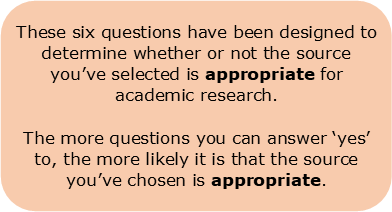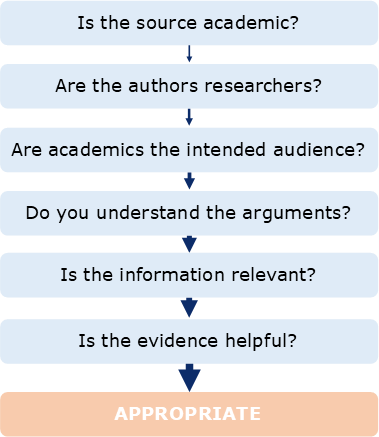What makes a source appropriate for academia?

This is the second of three chapters about Identifying Source Value. To complete this reader, read each chapter carefully and then unlock and complete our materials to check your understanding.
– Explore the concept of source appropriacy in academic research
– Provide six questions for determining source appropriacy
– Use examples to help explain these concepts and guide the reader towards finding appropriate academic sources
Before you begin reading...
-
video and audio texts
-
knowledge checks and quizzes
-
skills practices, tasks and assignments
Chapter 2
In this second chapter on identifying source value, we now turn our attention to the questions that students should ask themselves when determining whether or not the sources they’ve selected can form relevant (and convincing) arguments, and whether these sources are more generally appropriate for academic research. While Chapter 1 provided instruction about judging the value of a larger collection of sources in order to reduce the number of search results, this chapter now focuses on the select number of sources that a researcher would intend to read more carefully.


1. Is the source academic?
One of the first questions you should ask yourself is whether or not the source is academic in nature. As was outlined in Chapter 1, some sources such as educational textbooks or journal articles are specifically designed for academia, and as such are usually much more appropriate when used as evidence in research than those that are not. Such sources may be peer-reviewed to help guarantee reliability and are rarely created for the sole purposes of profiteering. That’s not to say that some sources such as social-networking websites aren’t appropriate for certain research topics, but for most subjects sources such as Facebook or Twitter probably are not.
2. Are the authors researchers?
One good sign that a source is appropriate for academic research is that it’s been authored by published academics and researchers. Professors of academic institutions are normally more likely to consider the veracity of their information than the author of an online blog or newspaper article, for instance. While such generalisations aren’t always guarantees of appropriacy, doing some quick online research into the authors of the source you’re uncertain about to determine their training and background may help you decide whether or not to keep that source or discard it altogether.
3. Are academics the intended audience?
Another way of judging the appropriacy of a source is by finding out who that source was published for. Is the source targeted at primary school children for example, or at university students? Was it printed for the keen eyes of researchers or for the glance of the general public? That’s not to say that a public source such as a newspaper article cannot be useful for academic research, but having some understanding of the target audience may help a researcher to more clearly see (and avoid being influenced by) any bias or sales tactics within that text.
4. Do you understand the arguments?
One critical question you should ask yourself when conducting academic research is whether or not you understand the content and concepts of the source you’ve just read. Although non-native speakers of English are particularly likely to have misunderstood a text on first read, even native speakers find more complicated textbooks and journal articles to be somewhat dense and confusing from time to time. Try to read the source more than once, breaking it down into its key arguments. If after that you still can’t understand the information it contains, then consider dropping that source altogether. If you try to include any ideas that you’ve misunderstood, sources such as this will only weaken your argumentation. What’s more, your tutor may know the texts you’ve selected quite well and see, without difficulty, where you’ve omitted or misinterpreted some critical information.
5. Is the information relevant?
Even after skimming and scanning a source (by checking its title, abstract, contents list and images) and deciding that it should be quite useful, a closer inspection may later reveal the opposite. If there’s insufficient discussion of the specific topic you’re researching, you should perhaps consider disregarding that source altogether. By continuing to include an irrelevant source in your assignment, you may find yourself deviating from your research question and therefore losing marks – simply because you couldn’t determine which sources were most valuable.
6. Is the evidence helpful?
Finally, it’s wise to remember that a successful researcher never reads without purpose, and hopefully you’ve been reading your sources with some body-paragraph main ideas in mind. While the overall content of the source you’ve selected might be somewhat relevant, check carefully that it also provides evidence that directly offers support for one of your counter arguments or arguments. If the source doesn’t, and isn’t able to provide anything useful for your introductory background information either, seriously consider discarding it altogether. Even if you spent many hours reading and deciphering a journal article, if you’re struggling to think of how to use the information within your work then don’t be afraid to label that source as irrelevant or inappropriate for your particular research. When deciding which evidence to include in an essay, it’s important to be careful and selective.
Downloadables
Once you’ve completed all three chapters about identifying source value, you might also wish to download our beginner, intermediate and advanced worksheets to test your progress or print for your students. These professional PDF worksheets can be easily accessed for only a few Academic Marks.
Collect Academic Marks
-
100 Marks for joining
-
25 Marks for daily e-learning
-
100-200 for feedback/testimonials
-
100-500 for referring your colleages/friends